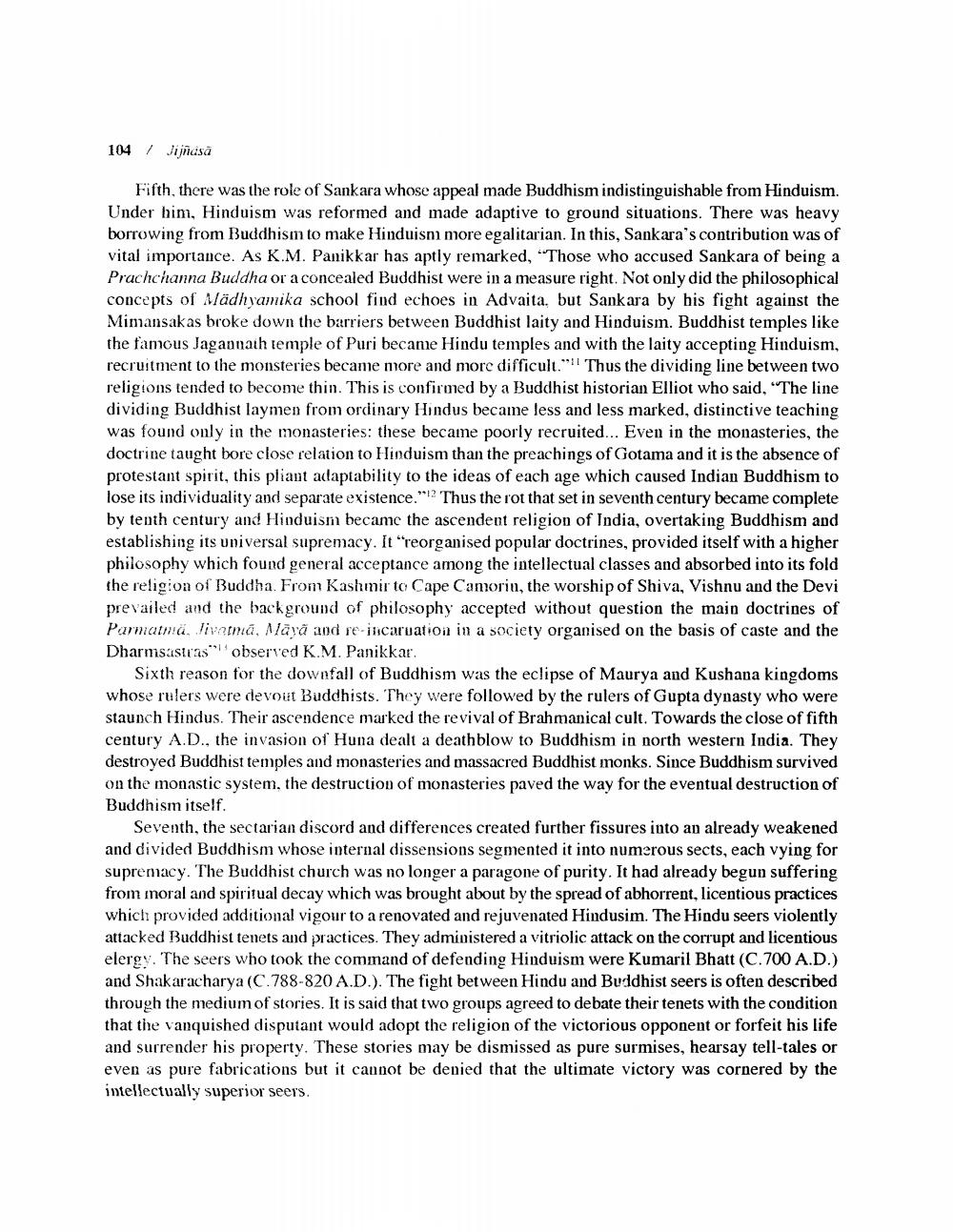________________
104 / Jijñāsä
Fifth, there was the role of Sankara whose appeal made Buddhism indistinguishable from Hinduism. Under him, Hinduism was reformed and made adaptive to ground situations. There was heavy borrowing from Buddhism to make Hinduism more egalitarian. In this, Sankara's contribution was of vital importance. As K.M. Panikkar has aptly remarked, "Those who accused Sankara of being a Prachchanna Buddha or a concealed Buddhist were in a measure right. Not only did the philosophical concepts of Madhyamika school find echoes in Advaita, but Sankara by his fight against the Mimansakas broke down the barriers between Buddhist laity and Hinduism. Buddhist temples like the famous Jagannath temple of Puri became Hindu temples and with the laity accepting Hinduism, recruitment to the monsteries became more and more difficult." Thus the dividing line between two religions tended to become thin. This is confirmed by a Buddhist historian Elliot who said, "The line dividing Buddhist laymen from ordinary Hindus became less and less marked, distinctive teaching was found only in the monasteries: these became poorly recruited... Even in the monasteries, the doctrine taught bore close relation to Hinduism than the preachings of Gotama and it is the absence of protestant spirit, this pliant adaptability to the ideas of each age which caused Indian Buddhism to lose its individuality and separate existence." Thus the rot that set in seventh century became complete by tenth century and Hinduism became the ascendent religion of India, overtaking Buddhism and establishing its universal supremacy. It "reorganised popular doctrines, provided itself with a higher philosophy which found general acceptance among the intellectual classes and absorbed into its fold the religion of Buddha. From Kashmir to Cape Camoriu, the worship of Shiva, Vishnu and the Devi prevailed and the background of philosophy accepted without question the main doctrines of Parmatma. Jivatma, Maya and re-incaruation in a society organised on the basis of caste and the Dharmsastras observed K.M. Panikkar.
Sixth reason for the downfall of Buddhism was the eclipse of Maurya and Kushana kingdoms whose rulers were devout Buddhists. They were followed by the rulers of Gupta dynasty who were staunch Hindus. Their ascendence marked the revival of Brahmanical cult. Towards the close of fifth century A.D., the invasion of Huna dealt a deathblow to Buddhism in north western India. They destroyed Buddhist temples and monasteries and massacred Buddhist monks. Since Buddhism survived on the monastic system, the destruction of monasteries paved the way for the eventual destruction of Buddhism itself.
Seventh, the sectarian discord and differences created further fissures into an already weakened and divided Buddhism whose internal dissensions segmented it into numerous sects, each vying for supremacy. The Buddhist church was no longer a paragone of purity. It had already begun suffering from moral and spiritual decay which was brought about by the spread of abhorrent, licentious practices which provided additional vigour to a renovated and rejuvenated Hindusim. The Hindu seers violently attacked Buddhist tenets and practices. They administered a vitriolic attack on the corrupt and licentious elergy. The seers who took the command of defending Hinduism were Kumaril Bhatt (C.700 A.D.) and Shakaracharya (C.788-820 A.D.). The fight between Hindu and Buddhist seers is often described through the medium of stories. It is said that two groups agreed to debate their tenets with the condition that the vanquished disputant would adopt the religion of the victorious opponent or forfeit his life and surrender his property. These stories may be dismissed as pure surmises, hearsay tell-tales or even as pure fabrications but it cannot be denied that the ultimate victory was cornered by the intellectually superior seers.




